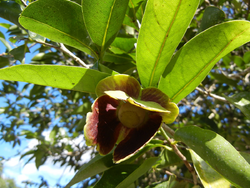Biology:Mosannona depressa
| Mosannona depressa | |
|---|---|

| |
| Flower and leaves of Mosannona depressa in the Yucatán | |
| Scientific classification | |
| Kingdom: | Plantae |
| Clade: | Tracheophytes |
| Clade: | Angiosperms |
| Clade: | Magnoliids |
| Order: | Magnoliales |
| Family: | Annonaceae |
| Genus: | Mosannona |
| Species: | M. depressa
|
| Binomial name | |
| Mosannona depressa (Baill.) Chatrou[2]
| |
| Synonyms | |
Mosannona depressa is an evergreen tree within the Annonaceae family native to tropical southern Mexico, Belize, Guatemala, and Honduras.
English common names include lancewood and wild soursop. Spanish common names include elemuy and yumel.[3]
Botany
A mature tree is generally 6–10 m (19-32') tall.
Chemistry
The bark contains significant amounts of alpha-asarone, but not its carcinogenic isomer beta-asarone, and other related trans-Propenylbenzene compounds.[4]
Medicinal Use
The bark of this tree is used by many people where it is native as medicine for gall stones.[5] The root, cooked with corn silk, was reported used to treat gonorrhea and kidney and bladder problems.[6]
Some more modern studies suggest this herb might have cholesterol-lowering properties.[7]
Toxicology
Extremely high doses (60 mg/kg) of pure alpha-asarone extracted from lancewood caused significant maternal harm when fed to pregnant mice. At doses of 15, 30 and 60 mg/kg, this compound was lethal to embryos and teratogenic.[8] These concentrations are far beyond what can be achieved using the plant as medicine and therefore has no bearing on whether or not it would cause problems in pregnancy.
References
- ↑ "IUCN Red List of Threatened Species". 2020. https://www.iucnredlist.org.
- ↑ "Mosannona depressa (Baill.) Chatrou". The Trustees of the Royal Botanic Gardens, Kew. n.d.. https://powo.science.kew.org/taxon/urn:lsid:ipni.org:names:1003577-1.
- ↑ Wiersema, JH; León, B (2016). World Economic Plants: A Standard Reference, Second Edition. Boca Raton, FL: CRC Press. ISBN 9781439821428. https://www.crcpress.com/World-Economic-Plants-A-Standard-Reference-Second-Edition/Wiersema-Leon/p/book/9781439821428.
- ↑ "Propenylbenzenes from Guatteria gaumeri". Phytochemistry 19 (9): 2024–2025. 1980. doi:10.1016/0031-9422(80)83029-9.
- ↑ "Pharmacology and toxicology of Guatteria gaumeri and alpha-asarone" (in es). Rev Invest Clin 45 (6): 597–604. Nov–Dec 1993. PMID 8159883.
- ↑ "Mosannona depressa". 2020. http://tropical.theferns.info/viewtropical.php?id=Mosannona+depressa.
- ↑ "Cholesterol-lowering effect of Guatteria gaumeri (preliminary report)". J Ethnopharmacol 6 (2): 239–242. 1982. doi:10.1016/0378-8741(82)90006-x. PMID 7132402.
- ↑ "Teratogenic action of alpha-asarone in the mouse" (in fr). J Toxicol Clin Exp 12 (3): 149–154. Aug 1992. PMID 1453351.
Wikidata ☰ Q15364277 entry
 |


